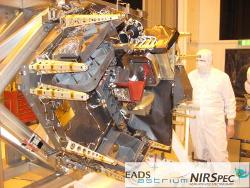Mar 31 2010
The cosmos is filled with color, and color is a key in determining age, chemical composition and how far objects are from Earth.
 The NIRSpec Engineering Test Unit was provided by the European Space Agency, with EADS-Astrium GmbH as Prime Contractor. NIRSpec will be the principal spectrographic instrument on board the Webb telescope
The NIRSpec Engineering Test Unit was provided by the European Space Agency, with EADS-Astrium GmbH as Prime Contractor. NIRSpec will be the principal spectrographic instrument on board the Webb telescope
To help identify these colors and objects the James Webb Space Telescope will be using a spectrograph called NIRSpec. Recently, the engineering test unit for the Webb telescope's Near-Infrared Spectrograph (NIRSpec) instrument arrived at NASA's Goddard Space Flight Center, Greenbelt, Md. from its manufacturer in Germany for preliminary testing.
"A spectrograph is an instrument that separates light into a spectrum," said Bernie Rauscher of NASA Goddard. "One example of a spectrograph that most folks know about is a chandelier (or diamond ring). When sunlight shines through it, it breaks it up into colors. NIRSpec analyzes those colors from deep space to help us solve mysteries." Rauscher is the Principal Investigator for the NIRSpec Detector Subsystem and the Deputy Project Scientist of the Webb's Integrated Science Instrument Module (ISIM).
The NIRSpec instrument will be the principal spectrographic instrument on-board the Webb telescope.
The components that make up NIRSpec will be sensitive to infrared wavelengths from the most distant galaxies and will be capable of obtaining spectra of more than 100 objects in the cosmos simultaneously. Determining an object's spectra is important, because it will help scientists determine the age, chemical composition and distances of faint galaxies. These measurements are key to unraveling the history of galaxy formation in the early Universe - one of the primary science goals of the Webb mission.
One unique technology in the NIRSpec that enables it to obtain those 100 simultaneous spectra is a micro-electromechanical system called a "microshutter array." NIRSpec's microshutter cells, each approximately as wide as a human hair, have lids that open and close when a magnetic field is applied. Each cell can be controlled individually, allowing it to be opened or closed to view or block a portion of the sky. It is this adjustability that allows the instrument to do spectroscopy on so many objects simultaneously. Because the objects NIRSpec will be looking at are so far away and so faint, the instrument needs a way to block out the light of nearer bright objects. Microshutters operate similarly to people squinting to focus on an object by blocking out interfering light.
NASA Goddard has a lot invested in the NIRSpec. Goddard built NIRSpec's detector and microshutter systems. EADS/Astrium is the European Space Agency's (ESA) prime contractor for the overall NIRSpec instrument. The prototype instrument was integrated and tested at Astrium's facility in Munich, Germany, before being shipped to Goddard.
Now that it has arrived at Goddard, the NIRSpec engineering test unit will go through pre-integration testing with the ISIM, which acts as a "chassis" to the Webb telescope observatory. Along with the other instruments, NIRSpec will be fitted into the ISIM, which is also currently at Goddard. The engineering test unit reproduces the physical, thermal, electrical and optical (up to the Micro-Shutter Array unit) properties of the flight model.
The James Webb Space Telescope is the next-generation premier space observatory, exploring deep space phenomena from distant galaxies to nearby planets and stars. The Webb Telescope will give scientists clues about the formation of the universe and the evolution of our own solar system, from the first light after the Big Bang to the formation of star systems capable of supporting life on planets like Earth.